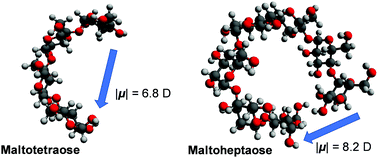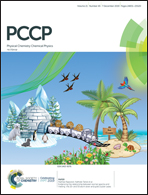Molecular motions, structure and hydration behaviour of glucose oligomers in aqueous solution
Abstract
The degree of polymerization and temperature dependencies of the molecular motions, configuration and hydration behaviour of glucose oligomers (Gn, n = 2 to 7, degree of polymerization) in aqueous solutions were investigated using extremely high-frequency dielectric spectrum measuring techniques up to 50 GHz. The obtained dielectric spectra for the aqueous Gn solutions were well decomposed into four Debye-type relaxation modes. The fastest relaxation mode j = 1 was assigned to the rotational process of free water molecules in the sample solution. The second fastest mode j = 2 was attributed to the exchange process of hydrated water molecules with free water molecules, and the third mode j = 3 was recognized as the rotational process of hydroxy groups attached to each repeating glucopyranoside (Glu) unit after their lifetimes of intramolecular hydrogen bonding. The slowest mode j = 4 at a relaxation time depending on n was assigned to the overall rotation of the Gn molecules possessing configurations similar to that of small fragments of single helical V-type crystalline structures at low temperatures. The presence of the dielectric mode j = 4 revealed that the Glu units possessed electric dipole moments carrying a component parallel to the Gn backbone aligned with the C1 → C4 direction. The number of hydrated water molecules per Glu unit (hydration number, nH) was determined for Gns in aqueous solutions in the temperature range from 10 °C to 70 °C via the relaxation strength of mode j = 1. The Gn oligomers were highly soluble in water within the temperature range examined, possessing nH values slightly dependent on n and demonstrated clear dehydration behaviour at approximately 30 °C with increasing temperature. These temperature dependencies of nH were substantially weaker than those of a model Glu unit compound, methyl α-D-glucopyranoside (G1). Then, the polymerization of glucose oligomers effectively depresses the dehydration behaviour of G1.



 Please wait while we load your content...
Please wait while we load your content...